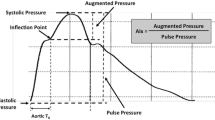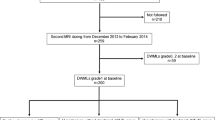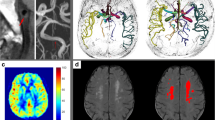Abstract
A healthy brain is essential for living a longer and fuller life. Detecting asymptomatic white matter hyperintensities (WMHs) may be clinically important in terms of treatment and prognostic evaluation. WMHs in brain may reflect brain aging. Androgenic alopecia (AGA) is associated with significant cardiovascular risk factors that also have a negative impact on brain aging. The main purpose of present study was to know whether alopecia might provide predictive information of WMHs that may be considered as a surrogate marker of cerebral small vessel disease which is related to arteriolosclerosis and vascular risk factors. From January 2017 to March 2018, 256 cases were enrolled consecutively. Patients under 18 years old, older than 90 years old, known to be affected by neurodegenerative diseases, demyelinating disorders or stroke and/or a brain tumor, were excluded from the study. A 4-point cerebral white matter Magnetic Resonance Imaging (MRI) hyperintensities scoring system, the Fazekas scale, was used to evaluate brain aging. Presence of AGA was evaluated with inspection according to Hamilton-Norwood classification system (grade I to VII). Two hundred eleven (82%) of individuals had mild alopecia (grade I, II, III), 28 (11%) had moderate alopecia (grade IV, V) and 17 (7%) had severe alopecia (grade VI, VII). Frequency of abnormal WMHs was significantly higher in patients with AGA compared to the without AGA. Hypertension (HT) (95% confidence interval [CI]: 1.873–9.487, p < 0.001) and the AGA (95% CI: 2.989–12.916, p < 0.0001) were independent determinants of abnormal WMHs. AGA may be regarded as a surrogate marker of asymptomatic WMHs which is related to arteriolosclerosis and vascular risk factors that has a significant impact on people’s life.

Similar content being viewed by others
References
Albert, C. M., Ma, J., Rifai, N., Stampfer, M. J., & Ridker, P. M. (2002). Prospective study of C-reactive protein, homocysteine, and plasma lipid levels as predictors of sudden cardiac death. Circulation, 105, 2595–2599.
Aljondi, R., Szoeke, C., Steward, C. et al. (2018). The effect of midlife cardiovascular risk factors on white matter hyperintensity volume and cognition two decades later in normal ageing women. Brain Imaging and Behavior. https://doi.org/10.1007/s11682-018-9970-5
Chen, W., Yang, C.-C., Chen, G.-Y., Wu, M. C., Sheu, H. M., & Tzai, T. S. (2004). Patients with a large prostate show a higher prevalence of androgenetic alopecia. Archives of Dermatological Research, 296(6), 245–249.
Crickx, B., & Descamps, V. (2007). Association of androgenetic alopecia and hypertension. European Journal of Dermatology, 17(3), 220–222.
Della-Morte, D., et al. (2018). Carotid intima-media thickness is associated with white matter hyperintensities: the Northern Manhattan study. Stroke, 49(2), 304–311.
Demark-Wahnefried, W., Lesko, S. M., Conaway, M. R., Robertson, C. N., Clark, R. V., Lobaugh, B., Mathias, B. J., Strigo, T. S., & Paulson, D. F. (1997). Serum androgens: associations with prostate cancer risk and hair patterning. Journal of Andrology, 18(5), 495–500.
Dogramaci, A., Balci, D., Balci, A., Karazincir, S., Savas, N., Topaloglu, C., & Yalcin, F. (2009). Is androgenetic alopecia a risk for atherosclerosis? Journal of the European Academy of Dermatology and Venereology, 23(6), 673–677.
Erdoğan, T., Kocaman, S. A., Çetin, M., Durakoğlugil, M. E., Uğurlu, Y., Sahin, I., & Çanga, A. (2013). Premature hair whitening is an independent predictor of carotid intima-media thickness in young and middle-aged men. Internal Medicine, 52(1), 29–36.
Ertas, R., Orscelik, O., Kartal, D., Dogan, A., Ertas, S. K., Aydogdu, E. G., et al. (2016). Androgenetic alopecia as an indicator of metabolic syndrome and cardiovascular risk. Blood Pressure, 25(3), 141–148.
Ertas, R., Orscelik, O., Kartal, D., Dogan, A., Ertas, S. K., Aydogdu, E. G., Ascioglu, O., & Borlu, M. (2016). Androgenetic alopecia as an indicator of metabolic syndrome and cardiovascular risk. Blood Pressure, 25(3), 141–148.
Ge, Y., Grossman, R. I., Babb, J. S., Rabin, M. L., Mannon, L. J., & Kolson, D. L. (2002). Age-related total gray matter and white matter changes in normal adult brain. Part I: volumetric MR imaging analysis. American Journal of Neuroradiology, 23(8), 1327–1333.
Ghaznawi, R., Geerlings, M. I., Jaarsma-Coes, M. G., et al. (2018). The association between lacunes and white matter hyperintensity features on MRI: The SMART-MR study. Journal of Cerebral Blood Flow & Metabolism. https://doi.org/10.1177/2F0271678X18800463
Giles, G. G., Severi, G., Sinclair, R., et al. (2002). Androgenetic alopecia and prostate cancer: findings from an Australian case-control study. Cancer Epidemiology and Prevention Biomarkers, 11(6), 549–553.
González-González, J. G., Mancillas-Adame, L. G., Fernández-Reyes, M., Gómez-Flores, M., Lavalle-González, F. J., Ocampo-Candiani, J., & Villarreal-Pérez, J. Z. (2009). Androgenetic alopecia and insulin resistance in young men. Clinical Endocrinology, 71(4), 494–499.
Herrera, C. R., D'Agostino, R. B., Gerstman, B. B., Bosco, L. A., & Belanger, A. J. (1995). Baldness and coronary heart disease rates in men from the Framingham study. American Journal of Epidemiology, 142(8), 828–833.
Hirsso, P., Laakso, M., Matilainen, V., Hiltunen, L., Rajala, U., Jokelainen, J., & Keinänen-Kiukaanniemi, S. (2006). Association of insulin resistance linked diseases and hair loss in elderly men. Finnish population-based study. Central European Journal of Public Health, 14, 78–81.
Hirsso, P., Rajala, U., Hiltunen, L., Jokelainen, J., Keinänen-Kiukaanniemi, S., & Näyhä, S. (2007). Obesity and lowgrade inflammation among young Finnish men with early-onset alopecia. Dermatology, 214, 125–129.
Hofman, A., Brusselle, G. G. O., Murad, S. D., van Duijn, C. M., Franco, O. H., Goedegebure, A., Ikram, M. A., Klaver, C. C. W., Nijsten, T. E. C., Peeters, R. P., Stricker, B. H. C., Tiemeier, H. W., Uitterlinden, A. G., & Vernooij, M. W. (2015). The Rotterdam study: 2016 objectives and design update. European Journal of Epidemiology, 30(8), 661–708.
IBM Corp. (2013). Released NY. Armonk: IBM Corp.
Inzitari, D. (2003). Leukoaraiosis an independent risk factor for stroke? Stroke, 34(8), 2067–2071.
Inzitari, D., Simoni, M., Pracucci, G., Poggesi, A., Basile, A. M., Chabriat, H., Erkinjuntti, T., Fazekas, F., Ferro, J. M., Hennerici, M., Langhorne, P., O'Brien, J., Barkhof, F., Visser, M. C., Wahlund, L. O., Waldemar, G., Wallin, A., Pantoni, L., & LADIS Study Group. (2007). Risk of rapid global functional decline in elderly patients with severe cerebral age-related white matter changes: the LADIS study. Archives of Internal Medicine, 167(1), 81–88.
Inzitari, D., Pracucci, G., Poggesi, A., Carlucci, G., Barkhof, F., Chabriat, H., Erkinjuntti, T., Fazekas, F., Ferro, J. M., Hennerici, M., Langhorne, P., O'Brien, J., Scheltens, P., Visser, M. C., Wahlund, L. O., Waldemar, G., Wallin, A., Pantoni, L., & on behalf of the LADIS Study Group. (2009). Changes in white matter as determinant of global functional decline in older independent outpatients: three year follow-up of LADIS (leukoaraiosis and disability) study cohort. Bmj, 339, b2477.
Kocaman, S. A., Çetin, M., Durakoğlugil, M. E., Erdoğan, T., Çanga, A., Çiçek, Y., Doğan, S., Şahin, I., Şatıroğlu, O., & Bostan, M. (2012). The degree of premature hair graying as an independent risk marker for coronary artery disease: a predictor of biological age rather than chronological age. Anadolu Kardiyoloji Dergisi, 12, 457–463.
Koedam, E. L., Lehmann, M., van der Flier, W. M., et al. (2011). Visual assessment of posterior atrophy development of a MRI rating scale. European Radiology, 21(12), 2618–2625.
Kuo, H.-K., & Lipsitz, L. A. (2004). Cerebral white matter changes and geriatric syndromes: is there a link? The Journals of Gerontology Series A: Biological Sciences and Medical Sciences, 59(8), M818–M826.
Lesko, S. M., Rosenberg, L., & Shapiro, S. (1993). A case-control study of baldness in relation to myocardial infarction in men. JAMA, 269(8), 998–1003.
Lin-Hui, S., Li-Sheng, C., Sheng-Che, L., et al. (2013). Association of Androgenetic Alopecia with mortality from diabetes mellitus and heart disease. JAMA Dermatology, 149(5), 601–606.
Lotufo, P. A., Chae, C. U., Ajani, U. A., Hennekens, C. H., & Manson, J. A. E. (2000). Male pattern baldness and coronary heart disease: the Physicians' health study. Archives of Internal Medicine, 160(2), 165–171.
Madden, D. J., & Parks, E. L. (2016). Diffusion Tensor Imaging and White Matter Hyperintensities. Cognitive Neuroscience of Aging: Linking Cognitive and Cerebral Aging. Oxford University Press, New York
Matilainen, V., Koskela, P., & Keinänen-Kiukaanniemi, S. (2000a). Early androgenetic alopecia as a marker of insulin resistance. The Lancet, 356(9236), 1165–1166.
Matilainen, V., Koskela, P., & Keinanen-Kiukaanniemi, S. (2000b). Early androgenetic alopecia as a marker of insulin resistance. Lancet, 356, 1165–1166.
Matilainen, V. A., Mäkinen, P. K., & Keinänen-Kiukaanniemi, S. M. (2001). Early onset of androgenetic alopecia associated with early severe coronary heart disease: a population-based, case-control study. Journal of Cardiovascular Risk, 8(3), 147–151.
McKee, A. C., & Daneshvar, D. H. (2015). The neuropathology of traumatic brain injury. In Handbook of Clinical Neurology, Elsevier, 127(4), 45–66. https://doi.org/10.1016/B978-0-444-52892-6.00004-0
Moroni, F., Ammirati, E., Rocca, M. A., Filippi, M., Magnoni, M., & Camici, P. G. (2018). Cardiovascular disease and brain health: focus on white matter hyperintensities. IJC Heart & Vasculature, 19, 63–69.
Pantoni, L. (2010). Cerebral small vessel disease: from pathogenesis and clinical characteristics to therapeutic challenges. The Lancet Neurology, 9(7), 689–701.
Pasceri, V., Willerson, J. T., & Yeh, E. T. (2000). Direct proinflammatory effect of C-reactive protein on human endothelial cells. Circulation, 102, 2165–2168.
Prins, N. D., & Scheltens, P. (2015). White matter hyperintensities, cognitive impairment and dementia: an update. Nature Reviews Neurology, 11(3), 157–165.
Rebora, A. (2001). Baldness and coronary artery disease: the dermatologic point of view of a controversial issue. Archives of Dermatology, 137(7), 943–947.
Ridker, P. M., Stampfer, M. J., & Rifai, N. (2001). Novel risk factors for systemic atherosclerosis: a comparison of C-reactive protein, fibrinogen, homocysteine, lipoprotein(a), and standard cholesterol screening as predictors of peripheral arterial disease. JAMA, 285, 2481–2485.
Sadighha, A., & Zahed, G. (2009). Evaluation of lipid levels in androgenetic alopecia in comparison with control group. Journal of the European Academy of Dermatology and Venereology, 23(1), 80–81.
Sarbu, N., Shih, R. Y., Jones, R. V., Horkayne-Szakaly, et al. (2016). White matter diseases with radiologic-pathologic correlation. Radiographics, 36(5), 1426–1447.
Smith, C. D., Johnson, E. S., Van Eldik, L. J., et al. (2016). Peripheral (deep) but not periventricular MRI white matter hyperintensities are increased in clinical vascular dementia compared to Alzheimer's disease. Brain and Behavior, 6(3), e00438.
Wahlund, L., Barkhof, F., Fazekas, F., Bronge, L., Augustin, M., Sjögren, M., Wallin, A., Ader, H., Leys, D., Pantoni, L., Pasquier, F., Erkinjuntti, T., Scheltens, P., & European Task Force on Age-Related White Matter Changes. (2001). A new rating scale for age-related white matter changes applicable to MRI and CT. Stroke, 32(6), 1318–1322.
Wallin, A., Roman, G. C., Esiri, M., et al. (2018). Update on vascular cognitive impairment associated with subcortical small-vessel disease. Journal of Alzheimer's Disease, 62(3), 1417–1441.
Wang, Y., Liu, G., Hong, D., Chen, F., Ji, X., & Cao, G. (2016). White matter injury in ischemic stroke. Progress in Neurobiology, 141, 45–60.
Wolf, P. A. (2012). Contributions of the Framingham heart study to stroke and dementia epidemiologic research at 60 years. Archives of Neurology, 69(5), 567–571.
Yassa, M., Saliou, M., De Rycke, Y., et al. (2011). Male pattern baldness and the risk of prostate cancer. Annals of Oncology, 22, 1824–1827.
Funding
This study was done in compliance with the Helsinki Declaration, good clinical practice guidelines of Turkey Ministry of Health and was approved by the local Scientific Research ethical committee of Kanuni Research and Education Hospital, Trabzon, Turkey (Approval number is 2017/46).
Author information
Authors and Affiliations
Corresponding author
Ethics declarations
Conflict of interest
The author declare that there is no conflict of interest that could be perceived as prejudicing the impartiality of the research reported.
Additional information
Publisher’s note
Springer Nature remains neutral with regard to jurisdictional claims in published maps and institutional affiliations.
Key Points
The degree of alopecia may be considered a surrogate marker of asymptomatic WMHs that are related to cerebral small vessel disease and vascular risk factors, which have significant impact on the quality of life of individuals. Assessing the degree of alopecia may be considered by the physicians because its detection does not require any specialized equipment or testing methods. Individuals with androgenetic alopecia may be referred to further examinations in to assess asymptomatic cerebral small vessel disease in the early phase.
Rights and permissions
About this article
Cite this article
Ata Korkmaz, H.A. Relationship between androgenic alopecia and white matter hyperintensities in apparently healthy subjects. Brain Imaging and Behavior 14, 527–533 (2020). https://doi.org/10.1007/s11682-019-00147-y
Published:
Issue Date:
DOI: https://doi.org/10.1007/s11682-019-00147-y




